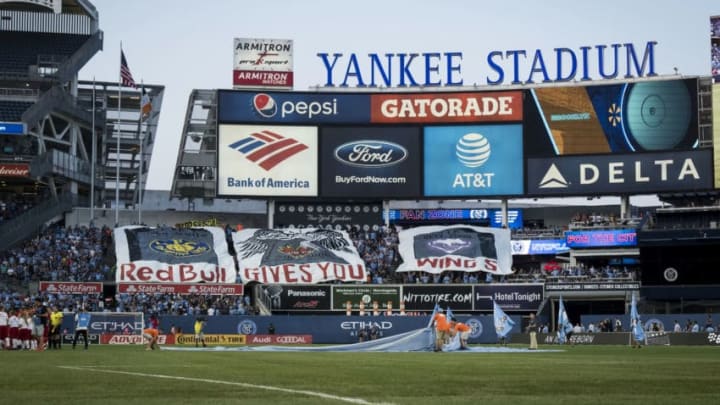Years ago, Don Garber was adamant that the New York City market was crucial to MLS success. As expansion continues, it is obvious that was not the case. In fact, the depreciation of the city’s significance in the soccer world now makes it a blight to the MLS product.
When Major League Soccer was founded in 1994, the believed having a relevant team in New York City was worth the effort. Now, decades later, the New York City market is an anchor holding back an ambitious league.
The plight of the New York MetroStars, now the New York Red Bulls, was rough for the first two decades. Now, the club has ownership committed to soccer development. The success of the Red Bulls academy is arguably the greatest in MLS. Red Bulls homegrown stars like Matt Miazga and Tyler Adams have an obvious path to bigger challenges in Europe while being able to compete for trophies from the beginning of their careers. But the Red Bulls’ successes are not matched by their neighbors.
The slapdash productions of New York City FC show that the hard lessons learned with New York’s team in New Jersey were not heeded by City Futbol Group or MLS Commissioner Don Garber. Of course, it could be argued that the problems of NYCFC were not the worries of MLS’ other owners. Garber and friends need not to look past anything once the huge expansion check was presented. But the success of the league is dependent on the success of the clubs that compose it.
Where the Red Bulls have tried to balance the roster between potential and worldwide stars, NYCFC went heavy on the star structure. The Red Bulls are having more on-field success using the academy first approach, which led to winning their first Supporters Shield trophy. They understood: there are only so many David Villa or Theirry Henry types that an MLS team can fit on a roster. Neglecting the back half of the roster is a recipe for an early offseason, every season.
But even with this revelation not being made until recently, and seemingly by only half the city, the on-field product is not the real problem with the MLS market in New York. It is the back end of the soccer club’s responsibilities that are to blame for both New York clubs falling short of expectations.
There’s a dead raccoon @ Yankee Stadium. #NYCFC #MLS pic.twitter.com/0jKwzdC72A
— Taylor Twellman (@TaylorTwellman) April 6, 2019
Racoons were fine in the old RFK stadium in Washington DC. In fact, they added to the ambience of watching a game while the floor bleachers swayed and the cement ceiling fell. But MLS is well past those days. Every other non-NYC team has had to find permanent digs to call home.
City Football Group is now in year five of a three-year plan to find a permanent home. There is a reason Beckham, Sacramento, and other cities have had to wait or lose their place in MLS expansion plans altogether. The negotiations usually hinge on the money behind the plan and the stadium.
More from MLS Multiplex
- Javier Milei Elected in Argentina: Potential Impacts on MLS and Signings of Argentine Players
- Orlando City and New York City FC in the Battle for Matías Arezo; Grêmio Enters Negotiations! Who Will Come Out on Top?
- USA, Honduras, Panama, and Canada Close in on a Spot in the 2024 Copa America
- De Gea Turns Down Al-Nassr’s Lucrative Offer: Speculation Points to Possible Reunion with Messi at Inter Miami
- Messi’s Magnetic Impact in the United States
Meanwhile, the New York Red Bulls have to market the club better to address the attendance woes. Plenty of international and future USMNT stars have donned the Red Bulls jersey in front of sparse crowds. Ceding the city to NYCFC might not be the plan, but it’s definitely the perspective seen from the other time zones.
New York City FC is doing very little to capitalize what’s left of any honeymoon period with New York City’s soccer market. Aging stars have yet to bring any trophies to the allegedly temporary home of Yankee Stadium. Only David Villa lived up to his billing. This team cannot be the marquee billing in New York until CFG builds a proper stadium.
New York is a marquee city. Anything feeling second-rate or being presented as an afterthought will never succeed in New York City. Because of that, MLS cannot prop up these clubs as flagship franchises. And that is what most leagues wish to do with their New York-based properties. Understandably so, given the size and significance of the city.
Garber wanted two clubs in New York’s metro area, despite the red flags on lessons learned in the league’s more unstable era. Now, Garber has two New York clubs that are practically irrelevant in the city. Instead of NYC teams being league leaders, the Big City is now behind most of middle America when considering progress made in the professional soccer market.
Garber and the MLS owners could probably use the expansion ruse another decade to paper over the shortcomings of any other market. But not New York. The negativity surrounding these two clubs is starting to creep into the greater MLS narrative. These New York teams are now more anvil around the neck of MLS, rather than anchors for league progress. And that is a great problem.
